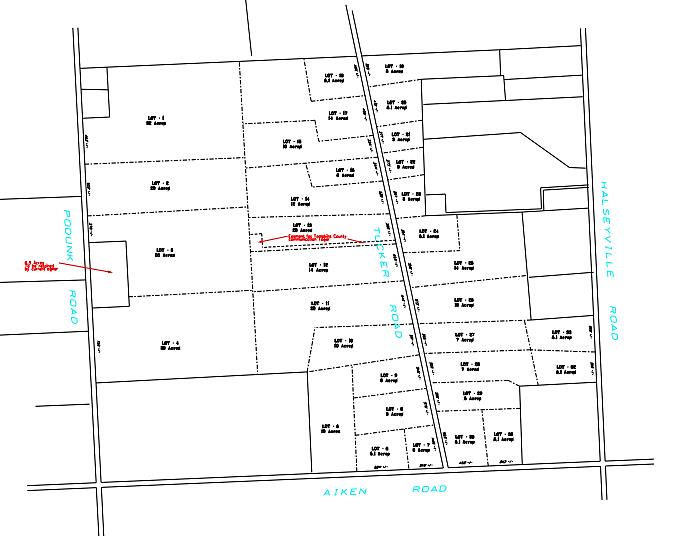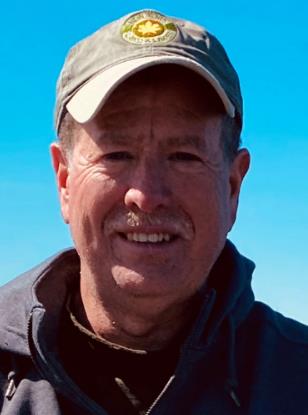
by Robert Lynch, December 8, 2022
If you want to draw people to a public meeting, try stuffing flyers into mailboxes. Yes, it’s illegal. But at least in Enfield, it gets results.
Case in point: An otherwise-routine monthly session of the Enfield Planning Board turned lively Wednesday night and drew the largest attendance of any meeting of any Board in the town post- pandemic. Some two dozen attendees filled virtually every seat in the room—some chose to stand—after an anonymous somebody filled mailboxes along Halseyville, Podunk, and Aiken Roads and elsewhere with leaflets warning of Land & Lakes Development’s plan to subdivide into building lots a three-parcel, 337-acre tract between Podunk and Halseyville Roads.
Project Manager Alan Lord had only planned to give the Planning Board a quiet introduction Wednesday. What he hadn’t expected was a roomful of listeners…. and critics.
“This is just an informal review,” surveyor Lord assured planners as he outlined his firm’s proposed 33-lot “Breezy Meadows Farm” subdivision. “There’s no timetable for anyone buying the land,” he said.
Wednesday’s meeting was not a public hearing. And because it wasn’t, Board Chairman Dan Walker declined to invite resident comment. Yet some availed themselves of the proceeding’s informal nature to offer their opinions anyway.
“We don’t want the character of the area changed,” said one man, who sat behind this Councilperson/reporter at Wednesday’s meeting. “That’s why this place is filled tonight,” he added.
“I thank you,” another attendee spoke to the room and to its beyond, commending the anonymous informant who skirted federal law by dropping the project’s map into his mailbox.
By Enfield’s rules, a subdividing party like Land & Lakes must advise neighbors within a certain radius of its development plans prior to a Public Hearing. But a hearing won’t likely occur until next March at the earliest. Wednesday’s turnout was, instead, the hearing’s appetizer.
Yet for anyone who’d like to stop “Breezy Meadows” dead in its tracks, there could be problems.
“There’s nothing in our subdivision regulations that would preclude this subdivision,” Chairman Walker warned attendees.
Land & Lakes Development LLC, based in Oneonta, is in the business of subdividing and selling vacant land. It doesn’t build homes upon the lots it sells, Lord said.
“There won’t be 33 lots developed for houses all at once,” Lord assured the Planning Board. What’s more, he said, “People often buy one, two, or three lots together,” making their home site a larger tract.
Land & Lakes’ property plat was the only document presented planners Wednesday. Breezy Meadows’ 33 lots would span both sides of Tucker Road and occupy portions of overgrown fields from Podunk to Halseyville Roads. Subdivided lots would include the 13, long-vacant, decaying, one-story barns that the Babcock Hatchery once used. Much of the remaining land has been abandoned to weeds. Residents reported to the Board that much of it hasn’t been farmed for several years at least.
Records filed with the Tompkins County Clerk indicate the land’s owner is the John William Kenney Revocable Trust. Kathryn Wiechec is its Trustee.
In dividing the tract into building lots, “we tried to make sense,” Alan Lord told the Planning Board. The proposed boundary lines, he said, attempt to follow hedgerows and other natural features. The average lot size, Lord said, is ten acres. Yet his survey puts some lots as small as three acres, others as large as 32.
And as to those long Babcock barns, Lord said, survey lines would not cut through any of the buildings.
Of the various barns on the property, the project manager said, “Some are in good shape; some are in rough shape.” A walk through the Babcock complex this date, later alleged a trespass, confirmed the latter. In one instance, a barn roof had partially collapsed.
Board member Mike Carpenter wondered about the barns’ contents and whether those contents’ disposal would raise any issues. Alan Lord thought they wouldn’t.
“This is not a one-meeting process,” Chair Walker assured his skeptical audience. “This is just sketch plan review.”
Project Manager Lord, joined at Wednesday’s meeting by the firm’s Managing Partner, Bob Lesperence, was advised to submit subdivision maps before February. An environmental assessment will also be required, the extent of which the Board has yet to determine. The Board must also assess the 337-acre tract’s status within an Agricultural District.

“It’s farmable land, but not prime farmable land,” Walker opined. Nonetheless, he added, “Protecting as much farmable land as possible is what we should look at.”
Also on the mind of Enfield Planners is the impact new housing might have on any underground aquifer, on federally-identified wetlands, and perhaps most importantly, on the drivability of Tucker Road, the lightly-traveled gravel road that cuts the proposed subdivision almost in half.
After both the developer and the roomful of neighbors had departed, Walker and the Board resumed their often sleep-inducing, months-long review of subdivision regulations. And as they did, Tucker Road returned to their minds and conversation.
“If they put 15 houses on Tucker Road, they’ll have to do something,” Walker said, concluding that the seldom-traveled side road—purportedly plowed for snow by the Highway Department only once per day—won’t stand up to 100-car-per-day traffic.
“If they’re going to put 15 lots on the road, is it unreasonable to ask will you (the developer) help us fix up Tucker Road,” Walker said to the Board. Requiring a developer to upgrade existing infrastructure when new lots would use only existing roads and not new ones, would be something Enfield law currently fails to demand.
After the developer’s presentation, and outside the meeting room, Land & Lakes Lesperence suggested that in view of the public’s and Board’s concerns that night, his firm may place deed restrictions on what prospective purchasers could develop. For example, the company could prohibit the placement of mobile homes on lots sold.
Lesperence said Land & Lakes had recently subdivided a 900-acre tract in Dryden into 43 building lots and gained community acceptance there.
Overall, the Planning Board’s greatest concern Wednesday was the subdivision’s impact on the rural character of Enfield, and exactly how the planners might mitigate resulting damage.
Alan Lord conceded to the Planning Board that Land & Lakes does not yet own the property. Indeed, road signs adjacent to the tract instruct potential buyers to contact agent Chelsea Smith of Hart and Homes Re/Max realty.
Reached by this writer, Smith Thursday confirmed that although Land & Lakes has signed a purchase contract, it has not yet closed on the purchase, and that her agency’s signs will remain up until the closing takes place.
Smith would not disclose the tract’s purchase price prior to closing.
“The trust made clear it wanted all of the combined parcels marketed to one developer and were not interested in selling off individual lots,” Smith stated. She indicated that multiple parties had expressed interest in the land, but that the trustee chose Land & Lakes as its preferred bidder.
And questioned as to whether Alan Lord’s presentation to the Planning Board might have been premature since the deal has not yet closed, Smith responded, “Land & Lakes is protecting what they’re purchasing; they want to make sure they can do what they’re hoping to do.”
Relaying what she claimed were trustee Kathryn Wiechec’s instructions, later confirmed, Chelsea Smith directed this Councilperson not to post photographs he’d taken when walking portions of the property Thursday. She also instructed that no one, not even potential buyers, should inspect the property without prior appointment.
Neighborhood objections aside, the Breezy Meadows debate may raise for planners doubts regarding the adequacy of Enfield’s subdivision rules as they interface with the Town Comprehensive Plan, whose stated intent is to preserve Enfield’s “rural character.”
“All are acceptable as building lots,” Chair Dan Walker informed his Planning Board colleagues as they eyed Breezy Meadows’ plat, “but maybe not the best use of the land.”
###

